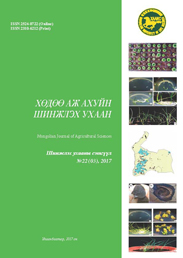Comparative evaluation of the seasonal dynamics of live weight of mares of different genotypes
DOI:
https://doi.org/10.5564/mjas.v22i03.947Keywords:
mare, genotype, season, physiological state, live weight, adaptive dynamics,Abstract
The article presents the results of a study of the adaptive dynamics of a live weight of native mares Khakass groups Orlov trotter, Russian trotter breed and Russian Heavy Draft. In horse breeding at the year-round grazing horses, the main problem associated with adverse to the body of animals and the longest winter tebenevochnym period. Quality wintering herd horses depends largely on the ability to retain fatness (conditionally resistance) during this difficult period. Applied today assessment of the herd of horses that are on tebenevke by visual inspection, does not allow to identify the start of a sharp loss of body weight, as a result of animals are depleted, which leads to an increase in the number of abortions in mares and waste both young and adult population. Investigations were carried out to study the adaptive dynamics of a live weight of mares in a year-round grazing for timely identification of the onset of critical changes. Degree horses adapt to seasonal rhythms in a year-round grazing animals reflects their annual dynamics of live weight. This indicator is one of the criteria for adaptation to breeding conditions. Comparative seasonal dynamics of the live weight of the mares of different genotypes studied by seasons by the formula AA Motorina [1]. During the year, the mares of different genotypes reacted differently to the drastically changing feed, temperature, physiological, and others. Factors. Hardier mare were Khakass groups. They are less than animals of other genotypes, react to the current level of feeding and management, sharp temperature changes. What does the change of body weight in the autumn-winter period (1.0-1.9 vs. 2.5-3.8%), autumn-spring (against 15,9-17,4 17,0-20,9) and autumn-summer (against 10,4-11,3 10,8-13,0%), indicating that a good adaptation mares Khakass groups to environmental factors.
Downloads
1558
Downloads
Published
How to Cite
Issue
Section
License
Copyright on any research article in the Mongolian Journal of Agricultural Sciences is retained by the author(s).
The authors grant the Mongolian Journal of Agricultural Sciences a license to publish the article and identify itself as the original publisher.

Articles in the Mongolian Journal of Agricultural Sciences are Open Access articles published under a Creative Commons Attribution 4.0 International License CC BY.
This license permits use, distribution and reproduction in any medium, provided the original work is properly cited.




